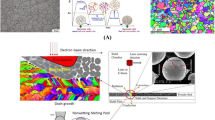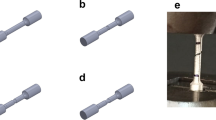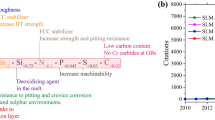Abstract
In the present study, molecular dynamics (MD) simulations are applied to investigate the polishing process of cubic silicon carbide (3C-SiC) with a rotating abrasive. The influence of abrasive rotational speed and rotation axis orientation on the friction characteristics and deformation behaviors of 3C-SiC is studied. The results show that as the rotational speed increases, the normal force first increases until it reaches its maximum at 25 rad/ns and then decreases. The evolution of transverse force with the rotational speed is more complicated and the smallest transverse force and friction coefficient are obtained at the rotational speed of 50 rad/ns. Besides, the transverse force increases while the normal force decreases with the rotation angle when the angular velocity vector of the rotational abrasive is parallel to the substrate surface. The case when the rotational speed is 25 rad/ns and the rotation angle is 0 is a significant critical situation. At the critical situation, we observe the lowest material removal rate, the deepest subsurface damage layer, the biggest high stress region and the smallest high temperature region for all rotational speeds and rotation axis orientations. Moreover, in the simulations, phase transformation (mainly amorphization) induced by high pressure is more pronounced than that by thermal effect. The results gained can shed light on the atomic-scale material removal and deformation mechanisms of 3C-SiC during polishing process.
Graphic Abstract





















Similar content being viewed by others
References
Wu, R.B., Zhou, K., Yue, C.Y., Wei, J., Pan, Y.: Recent progress in synthesis, properties and potential applications of SiC nanomaterials. Prog. Mater. Sci. 72, 1–60 (2015). https://doi.org/10.1016/j.pmatsci.2015.01.003
Tanaka, H.: Silicon carbide powder and sintered materials. J. Ceram. Soc. Jpn. 119, 218–233 (2011). https://doi.org/10.2109/jcersj2.119.218
Zhu, B., Zhao, D., Zhao, H.: A study of deformation behavior and phase transformation in 4H-SiC during nanoindentation process via molecular dynamics simulation. Ceram. Int. 45(4), 5150–5157 (2019). https://doi.org/10.1016/j.ceramint.2018.10.261
Yan, J.W., Gai, X.H., Harada, H.: Subsurface damage of single crystalline silicon carbide in nanoindentation tests. J. Nanosci. Nanotechnol. 10(11), 7808–7811 (2010). https://doi.org/10.1166/jnn.2010.2895
Luo, Q., Lu, J., Xu, X.: Study on the processing characteristics of SiC and sapphire substrates polished by semi-fixed and fixed abrasive tools. Tribol. Int. 104, 191–203 (2016). https://doi.org/10.1016/j.triboint.2016.09.003
Zhao, L., Zhang, J.J., Pfetzing, J., Alam, M., Hartmair, A.: Depth-sensing ductile and brittle deformation in 3C-SiC under Berkovich nanoindentation. Mater. Des. 197, 109223 (2020). https://doi.org/10.1016/j.matdes.2020.109223
Nguyen, V.T., Fang, T.H.: Material removal and interactions between an abrasive and a SiC substrate: a molecular dynamics simulation study. Ceram. Int. 46(5), 5623–5633 (2020). https://doi.org/10.1016/j.ceramint.2019.11.006
Luo, J.F., Dornfeld, D.A.: Material removal mechanism in chemical mechanical polishing: theory and modeling. IEEE Trans. Semicond. Manuf. 14(2), 112–133 (2001). https://doi.org/10.1109/66.920723
Shi, X., Pan, G., Zhou, Y., Xu, L., Zou, C., Gong, H.: A study of chemical products formed on sapphire (0001) during chemical–mechanical polishing. Surf. Coat. Technol. 270, 206–220 (2015). https://doi.org/10.1016/j.surfcoat.2015.02.053
Chagarov, E., Adams, J.B.: Molecular dynamics simulations of mechanical deformation of amorphous silicon dioxide during chemical–mechanical polishing. J. Appl. Phys. 94, 3853–3861 (2003). https://doi.org/10.1063/1.1602551
Han, X.: Study micromechanism of surface planarization in the polishing technology using numerical simulation method. Appl. Surf. Sci. 253(14), 6211–6216 (2007). https://doi.org/10.1016/j.apsusc.2007.01.115
Mishra, M., Szlufarska, I.: Dislocation controlled wear in single crystal silicon carbide. J. Mater. Sci. 48, 1593–1603 (2013). https://doi.org/10.1007/s10853-012-6916-y
Zhou, P., Shi, X.D., Li, J., Sun, T., Zhu, Y.W., Wang, Z.K., Chen, J.P.: Molecular dynamics simulation of SiC removal mechanism in a fixed abrasive polishing process. Ceram. Int. 45, 14614–14624 (2019). https://doi.org/10.1016/j.ceramint.2019.04.180
Meng, B.B., Yuan, D.D., Xu, S.L.: Coupling effect on the removal mechanism and surface/subsurface characteristics of SiC during grinding process at the nanoscale. Ceram. Int. 45(2), 2483–2491 (2019). https://doi.org/10.1016/j.ceramint.2018.10.175
Goel, S., Stukowski, A., Luo, X.C., Agrawal, A., Reuben, R.L.: Anisotropy of single- crystal 3C–SiC during nanometric cutting. Model. Simul. Mater. Sc. 21, 065004 (2013). https://doi.org/10.1088/0965-0393/21/6/065004
Meng, B.B., Yuan, D.D., Xu, S.L.: Study on strain rate and heat effect on the removal mechanism of SiC during nano-scratching process by molecular dynamics simulation. Int. J. Mech. Sci. 151, 724–732 (2019). https://doi.org/10.1016/j.ijmecsci.2018.12.022
Zhao, L., Alam, M., Zhang, J.J., Janisch, R., Hartmaier, A.: Amorphization-governed elasto-plastic deformation under nanoindentation in cubic (3C) silicon carbide. Ceram. Int. 46, 12470–12479 (2020). https://doi.org/10.1016/j.ceramint.2020.02.009
Tian, Z.G., Xu, X.P., Jiang, F., Lu, J., Luo, Q.F., Li, J.M.: Study on nanomechanical properties of 4H-SiC and 6H-SiC by molecular dynamics simulations. Ceram. Int. 45, 21998–22006 (2019). https://doi.org/10.1016/j.ceramint.2019.07.214
Liu, B., Xu, Z.W., Wang, Y., Gao, X., Kong, R.J.: Effect of ion implantation on material removal mechanism of 6H-SiC in nano-cutting: a molecular dynamics study. Comput. Mater. Sci. 174, 109476 (2020). https://doi.org/10.1016/j.commatsci.2019.109476
Xiao, G.B., To, S., Zhang, G.Q.: The mechanism of ductile deformation in ductile regime machining of 6H SiC. Comput. Mater. Sci. 98, 178–188 (2015). https://doi.org/10.1016/j.commatsci.2014.10.045
Si, L.N., Guo, D., Luo, J.B., Lu, X.C., Xie, G.X.: Abrasive rolling effects on material removal and surface finish in chemical mechanical polishing analyzed by molecular dynamics simulation. J. Appl. Phys. 109, 084335 (2011). https://doi.org/10.1063/1.3575177
Si, L.N., Guo, D., Luo, J.B., Xie, G.X.: Planarization process of single crystalline silicon asperity under abrasive rolling effect studied by molecular dynamics simulation. Appl. Phys. A 109(1), 119–126 (2012). https://doi.org/10.1007/s00339-012-7026-z
Nguyen, V.T., Fang, T.H.: Material removal and wear mechanism in abrasive polishing of SiO2/SiC using molecular dynamics. Ceram. Int. 46, 21578–21595 (2020). https://doi.org/10.1016/j.ceramint.2020.05.263
Nguyen, V.T., Fang, T.H.: Abrasive mechanisms and interfacial mechanics of amorphous silicon carbide thin films in chemical-mechanical planarization. J. Alloy Compd. 845, 156100 (2020). https://doi.org/10.1016/j.jallcom.2020.156100
Yang, T.H., Zhao, H.W., Zhang, L., Shao, M.K., Liu, H.D., Huang, H.: Molecular dynamics simulation of self-rotation effects on ultra-precision polishing of single-crystal copper. AIP Adv. 3(10), 102106 (2013). https://doi.org/10.1063/1.4824625
Luo, X.C., Goel, S., Reuben, R.L.: A quantitative assessment of nanometric machinability of major polytypes of single crystal silicon carbide. J. Eur. Ceram. Soc. 32, 3423–3434 (2012). https://doi.org/10.1016/j.jeurceramsoc.2012.04.016
Systèmes, D.: Materials Studio 2018. BIOVIA, San Diego (2018)
Zhu, P.Z., Fang, F.Z.: Molecular dynamics simulations of nanoindentation of monocrystalline germanium. Appl. Phys. A 108, 415–421 (2012). https://doi.org/10.1007/s00339-012-6901-y
Zhou, C., Shan, L., Hight, J.R., et al.: Influence of colloidal abrasive size on material removal rate and surface finish in SiO2 chemical mechanical polishing. Tribol. Trans. 45(2), 232–238 (2002). https://doi.org/10.1080/10402000208982545
Zhu, P.Z., Qiu, C., Fang, F.Z., Yuan, D.D., Shen, X.C.: Molecular dynamics simulations of nanometric cutting mechanisms of amorphous alloy. Appl. Surf. Sci. 317, 432–442 (2014). https://doi.org/10.1016/j.apsusc.2014.08.031
Sarikov, A., Marzegalli, A., Barbisan, L., Scalise, E., Montalenti, F., Miglio, L.: Molecular dynamics simulations of extended defects and their evolution in 3C–SiC by different potentials. Modell. Simul. Mater. Sci. Eng. 28, 015002 (2020). https://doi.org/10.1088/1361-651X/ab50c7
Chavoshi, S.Z., Luo, X.: Molecular dynamics simulation study of deformation mechanisms in 3C–SiC during nanometric cutting at elevated temperatures. Mater. Sci. Eng. A 654, 400–417 (2016). https://doi.org/10.1016/j.msea.2015.11.100
Erhart, P., Albe, K.: Analytical potential for atomistic simulations of silicon, carbon, and silicon carbide. Phys. Rev. B 71, 35211 (2005). https://doi.org/10.1103/PhysRevB.71.035211
Shi, X.L., Pan, G.S., Zhou, Y., Zou, C.L., Gong, H.: Extended study of the atomic step-terrace structure on hexagonal SiC (0 0 0 1) by chemical-mechanical planarization. Appl. Surf. Sci. 284, 195–206 (2013). https://doi.org/10.1016/j.apsusc.2013.07.080
Stokbro, K., Nielsen, E., Hult, E., et al.: Nature of bonding forces between two hydrogen-passivated silicon wafers. Phys. Rev. B 58(24), 16118 (1998). https://doi.org/10.1103/PhysRevB.58.16118
Ho, Y.H., Chiu, Y.H., Lu, J.M., Lin, M.F.: Low-energy electronic structures of nanotube–graphene hybrid carbon systems. Physica E 42, 744–747 (2010). https://doi.org/10.1016/j.physe.2009.10.043
Inui, N., Iwasaki, S.: Interaction energy between graphene and a silicon substrate using pairwise summation of the Lennard-Jones potential. e-J. Surf. Sci. Nanotechnol. 15, 40–49 (2017). https://doi.org/10.1380/ejssnt.2017.40
Homma, Y., Fukushima, K., Kondo, S., Sakuma, N.: Effects of mechanical parameters on CMP characteristics analyzed by two-dimensional frictional-force measurement. J. Electrochem. Soc. 150(12), G751 (2003). https://doi.org/10.1149/1.1619990
Salinas Ruiz, V.R., Kuwahara, T., Galipaud, J., et al.: Interplay of mechanics and chemistry governs wear of diamond-like carbon coatings interacting with ZDDP-additivated lubricants. Nat Commun 12, 4550 (2021). https://doi.org/10.1038/s41467-021-24766-6
Terrell, E.J., Higgs, C.F., III.: A Modeling approach for predicting the abrasive particle motion during chemical mechanical polishing. ASME. J. Tribol. 129(4), 933–941 (2007). https://doi.org/10.1115/1.2768614
Ilie, F.: Models of nanoparticles movement, collision, and friction in chemical mechanical polishing (CMP). J Nanopart Res. 14, 752 (2012). https://doi.org/10.1007/s11051-012-0752-5
Zhou, Y., Luo, H., Pan, G., et al.: Study on pad performance deterioration in chemical mechanical polishing (CMP) of fused silica. ECS J. Solid State Sci. Technol. 7(6), P295 (2018). https://doi.org/10.1149/2.0011806jss
Plimpton, S.: Fast parallel algorithms for short-range molecular dynamics. J. Comput. Phys. 117(1), 1–19 (1995). https://doi.org/10.1006/jcph.1995.1039
Nguyen, V.T., Fang, T.H.: Material removal and interactions between an abrasive and a SiC substrate: a molecular dynamics simulation study. Ceram. Int. 46, 5623–5633 (2020). https://doi.org/10.1016/j.ceramint.2019.11.006
Stukowski, A.: Visualization and analysis of atomistic simulation data with OVITO-the open visualization tool. Model. Simul. Mater. Sci. Eng. 18, 015012 (2009). https://doi.org/10.1088/0965-0393/18/1/015012
Li, J., Fang, Q.H., Zhang, L.C., Liu, Y.W.: Subsurface damage mechanism of high speed grinding process in single crystal silicon revealed by atomistic simulations. Appl. Surf. Sci. 324, 464–474 (2015). https://doi.org/10.1016/j.apsusc.2014.10.149
Goel, S., Luo, X.C., Reuben, R.L.: Molecular dynamics simulation model for the quantitative assessment of tool wear during single point diamond turning of cubic silicon carbide. Comput. Mater. Sci. 51(1), 402–408 (2012). https://doi.org/10.1016/j.commatsci.2011.07.052
Li, B.Z., Li, J.Y., Zhu, P.Z., Xu, J.H., Li, R., Yu, J.X.: Influence of crystal anisotropy on deformation behaviors in nanoscratching of AlN. Appl. Surf. Sci. 487, 1068–1076 (2019). https://doi.org/10.1016/j.apsusc.2019.05.218
Liu, Y., Li, B.Z., Kong, L.F.: Molecular dynamics simulation of silicon carbide nanoscale material removal behavior. Ceram. Int. 44, 11910–11913 (2018). https://doi.org/10.1016/j.ceramint.2018.03.195
Sun, S., Peng, X.H., Xiang, H.G., Huang, C., Yang, B., Gao, F.S.: Molecular dynamics simulation in single crystal 3C-SiC under nanoindentation: formation of prismatic loops. Ceram. Int. 43, 16313–16318 (2017). https://doi.org/10.1016/j.ceramint.2017.09.003
Maras, E., Trushin, O., Stukowski, A., et al.: Global transition path search for dislocation formation in Ge on Si (001). Comput. Phys. Commun. 205, 13–21 (2016). https://doi.org/10.1016/j.cpc.2016.04.001
Stukowski, A., Bulatov, V.V., Arsenlis, A.: Automated identification and indexing of dislocations in crystal interfaces. Model. Simul. Mater. Sci. Eng. 20, 085007 (2012). https://doi.org/10.1016/j.cpc.2016.04.001
Liu, C.L., He, W.B., Chu, J.N., Zhang, J.G., Chen, X., Xiao, J.F., Xu, J.F.: Molecular dynamics simulation on cutting mechanism in the hybrid machining process of single-crystal silicon. Nanoscale Res. Lett. 16, 66 (2021). https://doi.org/10.1186/s11671-021-03526-x
Cai, M.B., Li, X.P., Rahman, M.: Study of the mechanism of nanoscale ductile mode cutting of silicon using molecular dynamics simulation. Int. J. Mach. Tools Manuf. 47, 75–80 (2007). https://doi.org/10.1016/j.ijmachtools.2006.02.016
Xiao, G., To, S., Zhang, G.: Molecular dynamics modelling of brittle–ductile cutting mode transition: case study on silicon carbide. Int. J. Mach. Tool. Manuf. 88, 214–222 (2015). https://doi.org/10.1016/j.ijmachtools.2014.10.007
Zhu, P.Z., Hu, Y.Z., Ma, T.B., Wang, H.: Molecular dynamics study on friction due to ploughing and adhesion in nanometric scratching process. Tribol. Lett. 41, 41–46 (2011). https://doi.org/10.1007/s11249-010-9681-6
Zhu, P.Z., Hu, Y.Z., Wang, H., Ma, T.B.: Study of AFM-based nanometric cutting process using molecular dynamics. Appl. Surf. Sci. 256, 7160–7165 (2010). https://doi.org/10.1016/j.apsusc.2010.05.044
Zhou, P., Li, J., Wang, Z.K., Chen, J.P., Li, X., Zhu, Y.W.: Molecular dynamics study of the removal mechanism of SiC in a fixed abrasive polishing in water lubrication. Ceram. Int. 46, 24961–24974 (2020). https://doi.org/10.1016/j.ceramint.2020.06.282
Cross Graham, L.W.: Silicon nanoparticles: isolation leads to change. Nat. Nanotechnol. 6, 467–468 (2011). https://doi.org/10.1038/nnano.2011.124
Zhao, L., Zhang, J.J., Zhang, J.G., Hartmaier, A.: Atomistic investigation of machinability of monocrystalline 3C–SiC in elliptical vibration-assisted diamond cutting. Ceram. Int. 47, 2358–2366 (2020). https://doi.org/10.1016/j.ceramint.2020.09.078
Gao, Y., Brodyanski, A., Kopnarski, M., Urbassek, H.M.: Nanoscratching of iron: a molecular dynamics study of the influence of surface orientation and scratching direction. Comput. Mater. Sci. 103, 77–89 (2015). https://doi.org/10.1016/j.commatsci.2015.03.011
Alhafez, I.A., Ruestes, C.J., Bringa, E.M., Urbassek, H.M.: Indentation and scratching of iron by a rotating tool -a molecular dynamics study. Comput. Mater. Sci. 194, 110445 (2021). https://doi.org/10.1016/j.commatsci.2021.110445
Yin, Z.H., Zhu, P.Z., Li, B.Z.: Study of nanoscale wear of SiC/Al nanocomposites using molecular dynamics simulations. Tribol. Lett. 69, 38 (2021). https://doi.org/10.1007/s11249-021-01414-0
Yoshida, M., Onodera, A., Ueno, M., Takemura, K., Shimomua, O.: Pressure-induced phase transition in SiC. Phys. Rev. B 48(14), 10587–10590 (1993). https://doi.org/10.1103/PhysRevB.48.10587
Yoo, W.S., Nishino, S., Matsunami, H.: Single crystal growth of hexagonal SiC on cubic SiC by intentional polytype control. J. Cryst. Growth 99, 278–283 (1990). https://doi.org/10.1016/0022-0248(90)90527-R
Xiao, H., Wu, H., Chi, X.: SCE: Grid Environment for Scientific Computing. In: Vicat-Blanc Primet, P., Kudoh, T., Mambretti, J. (Eds) Networks for Grid Applications. GridNets 2008. Lecture Notes of the Institute for Computer Sciences, Social Informatics and Telecommunications Engineering, Vol. 2. Springer, Berlin (2009). https://doi.org/10.1007/978-3-642-02080-3_4
Acknowledgements
This work is supported by Beijing Natural Science Foundation (No. 3202024), National Natural Science Foundation of China (Nos. 51405337 and 51875405), Tribology Science Fund of State Key Laboratory of Tribology (No. SKLTKF20B13) and Beijing Institute of Technology Research Fund Program for Young Scholars. The MD simulations in this paper are performed on the China National Grid (http://www.cngrid.org) / China Scientific Computing Grid (http://www.scgrid.cn) [66].
Funding
This work is supported by Beijing Natural Science Foundation (No. 3202024), National Natural Science Foundation of China (Nos. 51405337 and 51875405), Tribology Science Fund of State Key Laboratory of Tribology (No. SKLTKF20B13) and Beijing Institute of Technology Research Fund Program for Young Scholars.
Author information
Authors and Affiliations
Corresponding author
Ethics declarations
Conflict of interest
The authors declare that they have no known competing financial interests or personal relationships that could have appeared to influence the work reported in this paper.
Additional information
Publisher's Note
Springer Nature remains neutral with regard to jurisdictional claims in published maps and institutional affiliations.
Rights and permissions
About this article
Cite this article
Yin, Z., Zhu, P., Li, B. et al. Atomic Simulations of Deformation Mechanism of 3C-SiC Polishing Process with a Rolling Abrasive. Tribol Lett 69, 146 (2021). https://doi.org/10.1007/s11249-021-01526-7
Received:
Accepted:
Published:
DOI: https://doi.org/10.1007/s11249-021-01526-7




